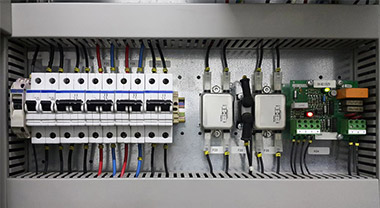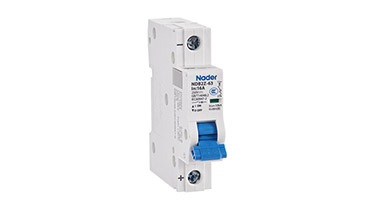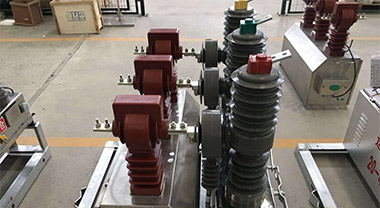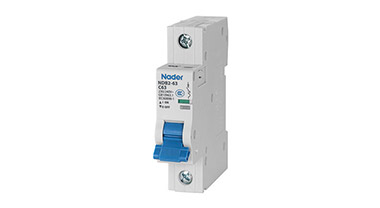Why does an arc appear when the circuit breaker opens and closes?
In the power network, the circuit breaker is used to break the current-carrying circuit, and the breaking of its contacts does not mean that the circuit is actually disconnected. When using a circuit breaker to cut off the circuit, if the current in the circuit is greater than 80-100mA, and the moving and static contacts of the circuit breaker have a voltage greater than 10-20V at the moment of separation, an arc will occur between the contacts. The arc is a plasma with high temperature and high conductivity. The so-called plasma is a state of a group of particles with the same number of positively charged and negatively charged particles, and is the fourth state of matter juxtaposed with solid, liquid, and gas. The arc has a great destructive effect on the contacts, and the arc continues to maintain the connection of the circuit. Only by extinguishing it can the circuit be truly cut off. Therefore, circuit breakers generally have a special arc extinguishing device to quickly and reliably extinguish the arc generated between the moving and static contacts of the circuit breaker. This is one of the important conditions for ensuring the normal operation of the circuit breaker.
The formation of an electric arc is the process of dissociating the nature points (molecules and atoms) between the contacts, mainly in the following ways:
(1) Strong electric field emission. At the beginning of the separation of the contacts of the circuit breaker with current, the distance between the contacts is very small and the electric field intensity is very high. When the electric field intensity on the cathode surface is greater than 3×106V/m, the electrons on the cathode surface will be pulled out, and the electric Under the action, it accelerates to the anode.
(2) Collision dissociation. When the drawn out high-speed electrons gain enough kinetic energy, they collide with the atoms or molecules of the medium between the contacts to release the electrons around the nucleus. The neutral point of the medium dissociates into free electrons and positive ions, which is called collision dissociation. . As a result of the continuous collision and dissociation, the charged particles between the contacts increase greatly. When the number accumulates to a certain extent, the conductivity of the medium changes, from an insulator to a conductor. Under the action of an external voltage, the medium is broken down and an arc is caused.
(3) Thermal isolation. Current passing through the arc gap (that is, the arc burning gap between the contacts) will generate a lot of heat, so that the central part of the arc maintains a high temperature. Under the action of high temperature, the speed of irregular heat movement at the nature point in the medium increases. When they have sufficient kinetic energy and collide with each other, new electrons and positive ions are dissociated, which is called thermal dissociation. The charged particles formed by thermal dissociation move to the cathode and anode respectively. The positive ions continue to collide with the cathode as they move to the cathode, keeping the cathode's electrons continuously emitting, so the current continues to circulate between the separated contacts in the form of an arc.
(4) Thermionic emission. After the arc is generated, due to its high temperature, the metal contact at high temperature will cause the free electrons inside to fly out of the metal surface to provide electrons that conduct current, which is called thermionic emission.
The formation of the arc is a complex and continuous process. When the circuit breaker trips and the contacts are just opened, the distance between the contacts is very small and the electric field is very strong. The cathode produces strong electric field emission and provides initial free electrons. Under the action of the strong electric field, the electrons accelerate to the anode and cause collision and dissociation. , So there are more electrons to produce more collision dissociation, so that the charged particles between the contacts increase in a large amount, the medium is broken down, an arc is generated, and the high temperature generated by the arc causes thermal dissociation and thermionic emission from the cathode. When the contact distance increases, the electric field intensity decreases, mainly due to thermal ionization and thermionic emission to maintain the arc. Since the arc discharge is mainly maintained by thermal ionization and thermionic emission, the voltage required to maintain the arc combustion does not need to be high.
In the arc, while the freeing occurs, the freeing process of reducing the charged particles is also carried out to weaken the arc. When the free and de-free processes reach equilibrium, the arc is in a stable combustion state. The main ways of de-freezing are recombination and diffusion.
(1) Compound. Recombination refers to the phenomenon in which charged particles of opposite sex attract each other, combine, and the charges neutralize each other. To complete the recombination process, two charged particles of opposite sex need to be in a very close range within a certain period of time. The greater their relative speed, the more difficult it is to recombine. Electrons are small in mass, easy to accelerate, and move much faster than ions, so the recombination between positive and negative ions is much easier than the recombination between electrons and positive ions. Usually electrons first attach to the neutral point to form negative ions, and then recombine with positive ions. Another way is to first attach electrons to the surface of the solid medium, and then attract positive ions for neutralization. The speed of recombination is related to factors such as ion concentration, temperature, pressure, and electric field strength.
(2) Diffusion. Diffusion refers to the phenomenon of charged particles escaping from the inside of the arc and entering the surrounding medium. It is caused by the irregular thermal movement of the charged particles. The greater the temperature difference and ion concentration difference between the arc and the surrounding medium, the stronger the diffusion effect.
It can be seen that dissociation and dissociation are a pair of contradictions. They coexist in the unity of the arc and run through the entire process of arc generation and extinguishment. When an arc is formed, freeing is the main aspect of the contradiction. Create certain conditions to transform the dissociation into the main aspect of contradiction, so that the arc can be extinguished. The main factors that affect freeing and freeing are the cooling method of the arc, the characteristics of the medium between the contacts, the material of the contacts, the voltage amplitude and the change characteristics of the two ends of the contacts, etc.




